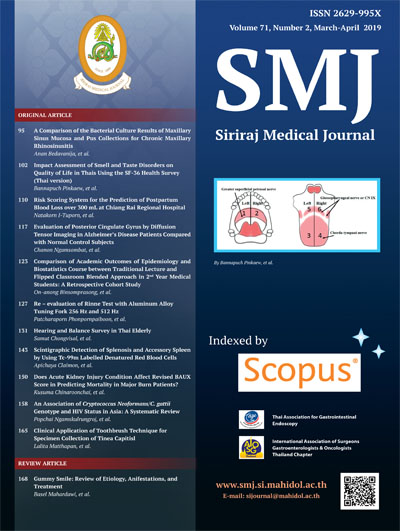Re – evaluation of Rinne Test with Aluminum Alloy Tuning Fork 256 Hz and 512 Hz
DOI:
https://doi.org/10.33192/Smj.2019.20Keywords:
Rinne; tuning fork; accuracy; conductive hearing loss; air-bone gapAbstract
Objective: To study the sensitivity, specificity and accuracy of the 256 Hz and 512 Hz aluminum tuning fork in
the detection of conductive hearing loss by quick Rinne test.
Methods: The patients with hearing problems recruited from out-patient unit were tested with the 256 Hz and 512
Hz aluminum quick Rinne test. The audiometry was performed on the same day and the results were compared.
Results: During the study period, 246 ears with conductive hearing loss and 246 ears with non-conductive hearing
loss were recruited. The 256 Hz Rinne test had higher sensitivity than the 512 Hz Rinne test (93.83% and 71.95%
respectively). The specificity and accuracy of the 512 Hz Rinne test was markedly greater than the 256 Hz Rinne
test (91.18 % vs. 26.7% specificity and 83.57% vs. 61.85% accuracy). The 512 Hz Rinne test had sensitivity over 80%
when the air-bone gap was equal to or greater than 20 dB. The sensitivity was even higher (more than 90%) if the
air-bone gap was equal to or greater than 30 dB.
Conclusion: This study demonstrated that the 512 Hz Rinne test had better accuracy than the 256 Hz Rinne test
for the diagnosis of conductive hearing loss. The 512 Hz Rinne test can detect the air-bone gap of 30 dB or greater
which indicates the surgical role with the sensitivity more than 90%. We recommend that 512 Hz Rinne test should
be used as a screening tool for the detection of conductive hearing loss.
Downloads
Published
How to Cite
Issue
Section
License
Authors who publish with this journal agree to the following conditions:
Copyright Transfer
In submitting a manuscript, the authors acknowledge that the work will become the copyrighted property of Siriraj Medical Journal upon publication.
License
Articles are licensed under a Creative Commons Attribution-NonCommercial-NoDerivatives 4.0 International License (CC BY-NC-ND 4.0). This license allows for the sharing of the work for non-commercial purposes with proper attribution to the authors and the journal. However, it does not permit modifications or the creation of derivative works.
Sharing and Access
Authors are encouraged to share their article on their personal or institutional websites and through other non-commercial platforms. Doing so can increase readership and citations.















